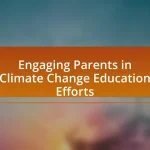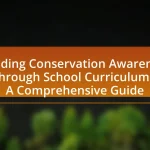The article examines the effects of urbanization on local wildlife, highlighting the negative impacts such as habitat loss, increased human-wildlife conflict, and alterations to ecosystems. It discusses how urban expansion leads to habitat fragmentation, reduced biodiversity, and changes in species behavior, particularly affecting amphibians, birds, and mammals. The article also explores specific changes in land use due to urbanization, the long-term consequences for wildlife populations, and strategies for mitigating these effects through urban planning and community initiatives. Key insights include the importance of creating wildlife corridors, integrating green spaces, and engaging local communities in conservation efforts to support urban biodiversity.
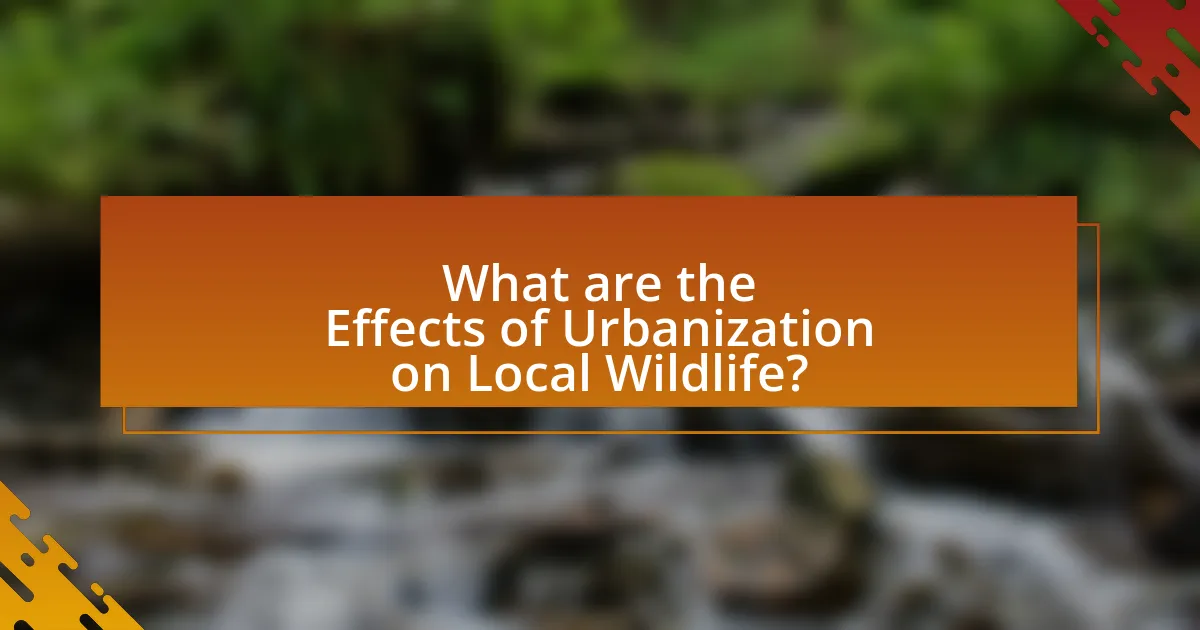
What are the Effects of Urbanization on Local Wildlife?
Urbanization negatively impacts local wildlife by reducing habitat availability, increasing human-wildlife conflict, and altering ecosystems. As cities expand, natural habitats are fragmented or destroyed, leading to a decline in biodiversity. For instance, a study published in “Ecological Applications” found that urban areas can reduce species richness by up to 75% compared to rural environments. Additionally, urbanization introduces pollutants and noise, which can disrupt animal behavior and reproduction. Research indicates that species such as birds and mammals often struggle to adapt to these changes, resulting in population declines and increased mortality rates.
How does urbanization alter natural habitats?
Urbanization significantly alters natural habitats by transforming land for human use, which leads to habitat fragmentation, loss of biodiversity, and changes in ecosystem dynamics. As cities expand, natural landscapes are replaced with buildings, roads, and infrastructure, disrupting the habitats of various species. For instance, studies indicate that urban areas can reduce local biodiversity by up to 50% due to habitat destruction and pollution, as reported in the research by McKinney (2002) in “Urbanization as a major cause of biotic homogenization.” This transformation not only displaces wildlife but also alters food webs and ecological interactions, further impacting the resilience of local ecosystems.
What specific changes occur in land use due to urbanization?
Urbanization leads to significant changes in land use, primarily through the conversion of natural landscapes into built environments. This transformation includes the replacement of forests, wetlands, and agricultural land with residential, commercial, and industrial developments. For instance, studies indicate that urban areas can expand by 1.5 to 3 times their original size over a few decades, resulting in habitat loss for local wildlife. Additionally, impervious surfaces such as roads and buildings increase, which disrupts natural water drainage and alters local ecosystems. These changes not only reduce biodiversity but also fragment habitats, making it difficult for wildlife to thrive.
How do these changes impact local ecosystems?
Urbanization significantly impacts local ecosystems by altering habitats, reducing biodiversity, and disrupting ecological processes. The construction of buildings, roads, and other infrastructure leads to habitat fragmentation, which isolates wildlife populations and limits their ability to find food, mate, and migrate. Studies indicate that urban areas can experience a decline in species richness, with some species disappearing entirely due to habitat loss and increased human activity. For example, research published in the journal “Ecological Applications” found that urbanization can reduce bird diversity by up to 50% in affected areas. Additionally, urban runoff can introduce pollutants into local waterways, further harming aquatic ecosystems. These changes collectively threaten the stability and resilience of local ecosystems, making them more vulnerable to environmental stressors.
What species are most affected by urbanization?
Urbanization most significantly affects species such as amphibians, birds, and mammals. Amphibians, like frogs and salamanders, experience habitat loss and fragmentation due to urban development, leading to population declines. Birds, particularly ground-nesting species, face increased predation and habitat alteration, which disrupts their breeding success. Mammals, including small rodents and larger species like deer, often struggle with habitat encroachment and increased human-wildlife conflict. Studies indicate that urban areas can reduce biodiversity by up to 50%, highlighting the severe impact of urbanization on these species.
Which animals are displaced by urban development?
Urban development displaces various animal species, including mammals, birds, reptiles, and amphibians. For instance, species such as deer, foxes, and raccoons often lose their habitats due to the expansion of urban areas. Additionally, birds like sparrows and songbirds are affected as their nesting sites are destroyed. Research indicates that urbanization leads to habitat fragmentation, which significantly impacts wildlife populations and biodiversity. A study published in the journal “Ecological Applications” highlights that urban sprawl can reduce the availability of natural habitats, forcing many species to relocate or face population decline.
How does urbanization affect biodiversity in local areas?
Urbanization negatively affects biodiversity in local areas by fragmenting habitats, reducing species richness, and altering ecosystems. As cities expand, natural landscapes are replaced with buildings and infrastructure, leading to habitat loss for many species. A study published in “Ecological Applications” by McKinney (2002) found that urban areas often support fewer species compared to rural areas due to these habitat changes. Additionally, urbanization introduces pollution and invasive species, further threatening local wildlife. Research indicates that urban environments can lead to a decline in native species populations, as they struggle to adapt to altered conditions.
What are the long-term consequences of urbanization on wildlife populations?
Urbanization leads to significant long-term consequences for wildlife populations, primarily through habitat loss, fragmentation, and increased human-wildlife conflict. Habitat loss occurs as natural areas are converted into urban environments, reducing the available space for wildlife to thrive. For instance, studies indicate that urban development can lead to a 50-90% reduction in suitable habitats for various species, particularly in biodiversity hotspots. Fragmentation further isolates wildlife populations, making it difficult for them to find mates, food, and migrate, which can result in decreased genetic diversity and increased extinction rates. Additionally, urban areas often create environments that are inhospitable to many species, while simultaneously attracting others, leading to shifts in local biodiversity. Increased human-wildlife conflict arises as animals encroach on urban areas in search of food and shelter, resulting in negative interactions that can harm both wildlife and humans. Overall, these factors contribute to declining wildlife populations and altered ecosystems in urbanized regions.
How does urbanization influence species survival rates?
Urbanization negatively influences species survival rates by altering habitats, increasing human-wildlife conflict, and introducing pollution. As urban areas expand, natural habitats are fragmented or destroyed, leading to reduced biodiversity and limiting the resources available for wildlife. For instance, a study published in “Ecological Applications” by McKinney (2002) found that urbanization can lead to a 50% decline in species richness in affected areas. Additionally, urban environments often create barriers that prevent species from migrating or accessing necessary resources, further threatening their survival.
What role does urbanization play in the extinction of local species?
Urbanization significantly contributes to the extinction of local species by altering habitats, increasing pollution, and fragmenting ecosystems. As cities expand, natural landscapes are transformed into urban environments, leading to habitat loss for many species. For instance, a study published in the journal “Biological Conservation” found that urban development has led to a 50% decline in biodiversity in some regions. Additionally, urban areas often introduce pollutants and invasive species, further stressing local wildlife. Fragmentation caused by roads and buildings isolates populations, making it difficult for species to find mates and resources, ultimately increasing their risk of extinction.
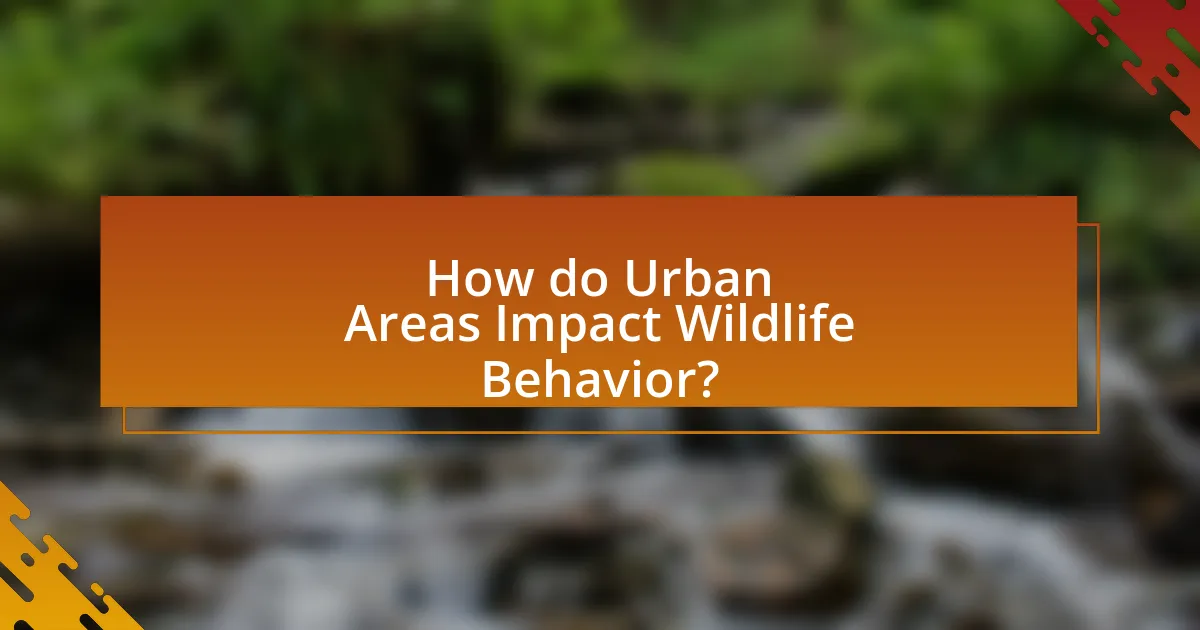
How do Urban Areas Impact Wildlife Behavior?
Urban areas significantly alter wildlife behavior by introducing habitat fragmentation, increased human activity, and artificial light. Habitat fragmentation leads to isolated populations, which can reduce genetic diversity and disrupt migration patterns. Increased human activity, such as noise and traffic, can cause wildlife to change their foraging and breeding behaviors, often leading to stress and avoidance of urban environments. Additionally, artificial light at night disrupts natural circadian rhythms, affecting nocturnal species’ hunting and mating behaviors. Studies have shown that species like raccoons and coyotes adapt to urban settings by altering their diets and activity patterns, demonstrating the profound impact of urbanization on wildlife behavior.
What behavioral changes do wildlife exhibit in urban environments?
Wildlife exhibit several behavioral changes in urban environments, including increased adaptability to human presence, altered foraging strategies, and changes in reproductive patterns. For instance, species such as raccoons and coyotes have become more nocturnal to avoid human activity, demonstrating a shift in their activity patterns. Additionally, urban wildlife often utilizes human-made structures for nesting and shelter, which indicates a behavioral adaptation to the availability of resources. Research by McKinney (2002) in “Urbanization as a major cause of biotic homogenization” highlights that urban environments can lead to increased competition among species, resulting in behavioral shifts that favor those that can thrive in altered habitats.
How does urban noise pollution affect animal communication?
Urban noise pollution disrupts animal communication by masking important vocal signals used for mating, territory establishment, and predator warning. Research indicates that many species, including birds and amphibians, alter their vocalizations in response to increased noise levels, often increasing volume or changing frequency to be heard over the din. For instance, a study published in the journal “Biology Letters” by Halfwerk et al. (2011) found that urban-dwelling birds adjusted their songs to higher frequencies, which can lead to miscommunication and reduced reproductive success. This alteration in communication patterns can ultimately affect population dynamics and biodiversity in urban environments.
What adaptations do animals make to thrive in urban settings?
Animals adapt to urban settings by altering their behavior, diet, and reproductive strategies. For instance, species like raccoons and pigeons have become more opportunistic feeders, utilizing human food sources and waste. Research indicates that urban birds often exhibit changes in song patterns to communicate effectively in noisy environments, while some mammals, such as foxes, have adapted their hunting techniques to exploit urban prey. Additionally, urban environments can lead to earlier breeding seasons in certain species, allowing them to take advantage of the warmer microclimates created by buildings and infrastructure. These adaptations are essential for survival in increasingly urbanized landscapes, demonstrating the resilience and flexibility of wildlife in response to human encroachment.
How does urbanization affect feeding and foraging behaviors?
Urbanization significantly alters feeding and foraging behaviors in wildlife. As urban areas expand, natural habitats are fragmented, leading to changes in food availability and foraging strategies. For instance, species such as raccoons and pigeons adapt by exploiting human food sources, which are often more abundant than natural prey. Research indicates that urban environments can increase the foraging efficiency of some species due to reduced competition and the presence of easily accessible food, such as garbage and bird feeders. A study by McKinney (2002) in “Urbanization as a major cause of biotic homogenization” highlights that urbanization can lead to a decline in native species that rely on specific foraging behaviors, while generalist species thrive. This shift in feeding patterns can disrupt local ecosystems and alter species interactions.
What food sources become available or scarce due to urbanization?
Urbanization leads to the availability of processed and convenience foods while causing a scarcity of local agricultural products. As cities expand, natural habitats are converted into urban areas, reducing farmland and local food production. This shift results in increased reliance on food imports and processed foods, which are more readily available in urban settings. According to the Food and Agriculture Organization, urban areas often experience a decline in local farming, leading to a decrease in fresh produce and traditional food sources.
How do animals adapt their foraging strategies in urban areas?
Animals adapt their foraging strategies in urban areas by altering their behavior to exploit new food sources and navigate human-dominated environments. For instance, species like raccoons and pigeons have learned to scavenge from human waste and food scraps, which are abundant in urban settings. Research indicates that urban-dwelling animals often exhibit increased nocturnal activity to avoid human disturbances, allowing them to forage more effectively during quieter hours. Additionally, some species, such as foxes, have adapted their hunting techniques to include foraging in parks and gardens, where they can find small mammals and fruits. These adaptations demonstrate the flexibility of wildlife in response to urbanization, as they modify their foraging patterns to thrive in altered landscapes.
What are the implications of altered wildlife behavior for urban ecosystems?
Altered wildlife behavior significantly impacts urban ecosystems by disrupting food webs and species interactions. For instance, urbanization often leads to changes in animal foraging patterns, which can result in overpopulation of certain species, such as raccoons and pigeons, while diminishing others. This shift can cause imbalances in local biodiversity, as seen in studies where increased human presence led to the decline of sensitive species like amphibians and small mammals. Additionally, altered behaviors can increase human-wildlife conflicts, as animals adapt to urban environments by scavenging for food, leading to potential health risks and property damage.
How does wildlife behavior influence urban human-wildlife interactions?
Wildlife behavior significantly influences urban human-wildlife interactions by determining the frequency and nature of encounters between species and humans. For instance, animals that adapt to urban environments, such as raccoons and pigeons, often exhibit behaviors that lead them to scavenge for food in human-dominated areas, increasing the likelihood of interactions. Research indicates that urban wildlife may become bolder and less fearful of humans, as seen in studies where urban foxes approached people more closely than their rural counterparts, demonstrating a behavioral shift due to the availability of resources and reduced predation risk. This behavioral adaptation can lead to conflicts, such as property damage or the spread of zoonotic diseases, highlighting the need for effective management strategies in urban planning to mitigate negative interactions.
What are the potential risks of wildlife adapting to urban life?
The potential risks of wildlife adapting to urban life include increased human-wildlife conflicts, exposure to pollutants, and loss of natural habitats. As wildlife becomes accustomed to urban environments, they may venture into populated areas, leading to dangerous encounters with humans, such as vehicle collisions or aggressive interactions. Additionally, urban areas often contain higher levels of pollutants, which can adversely affect the health of wildlife, leading to issues like reduced reproductive success and increased mortality rates. Furthermore, urbanization typically results in habitat fragmentation, which disrupts migration patterns and reduces genetic diversity among wildlife populations, ultimately threatening their long-term survival.
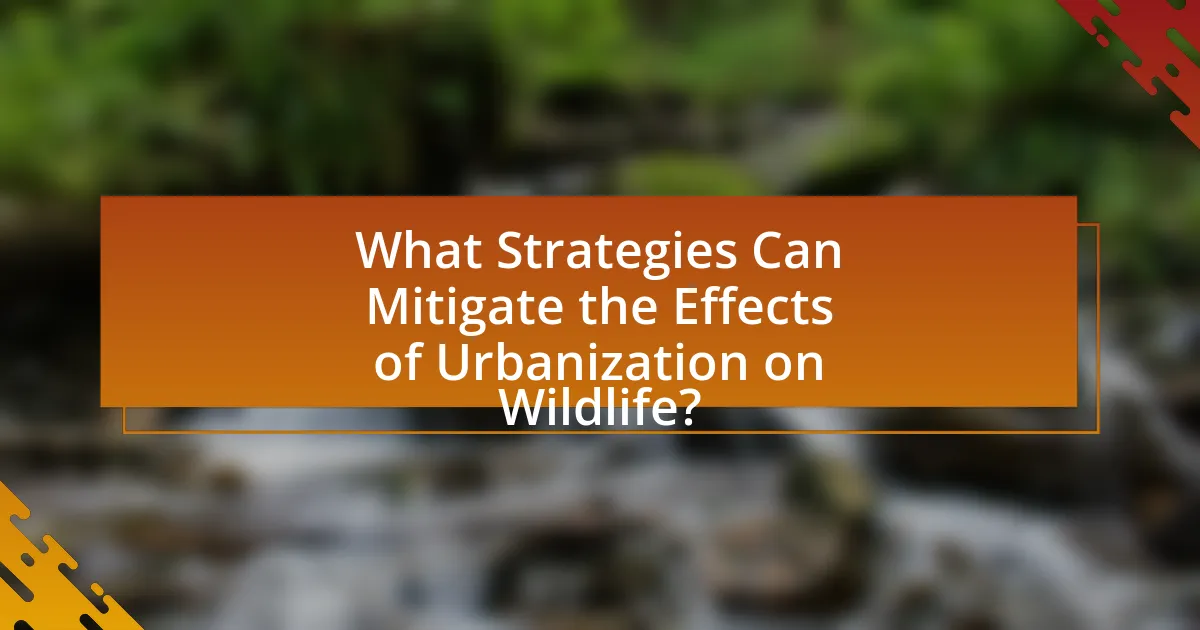
What Strategies Can Mitigate the Effects of Urbanization on Wildlife?
Strategies that can mitigate the effects of urbanization on wildlife include creating wildlife corridors, implementing green spaces, and enforcing habitat protection laws. Wildlife corridors facilitate safe movement between habitats, reducing roadkill and promoting genetic diversity. For instance, studies show that wildlife corridors can increase animal populations by up to 50% in fragmented landscapes. Green spaces, such as parks and urban gardens, provide essential habitats and resources for various species, enhancing urban biodiversity. Additionally, habitat protection laws can prevent further habitat loss and degradation, ensuring that remaining natural areas are preserved for wildlife. These strategies collectively contribute to maintaining ecological balance in urban environments.
How can urban planning incorporate wildlife conservation?
Urban planning can incorporate wildlife conservation by integrating green spaces, wildlife corridors, and sustainable land-use practices into urban designs. These elements facilitate habitat preservation and connectivity for wildlife, which is crucial as urban areas expand. For instance, the implementation of green roofs and urban parks can provide essential habitats for various species, while wildlife corridors can help mitigate the fragmentation caused by roads and buildings. Research indicates that cities with well-planned green infrastructure can support higher biodiversity levels, demonstrating the effectiveness of these strategies in promoting wildlife conservation within urban settings.
What design principles promote coexistence between urban areas and wildlife?
Design principles that promote coexistence between urban areas and wildlife include the integration of green spaces, wildlife corridors, and sustainable landscaping. Green spaces, such as parks and gardens, provide habitats and resources for various species, enhancing biodiversity within urban settings. Wildlife corridors facilitate safe movement for animals between fragmented habitats, reducing roadkill and promoting genetic diversity. Sustainable landscaping practices, such as using native plants and minimizing pesticide use, create environments that support local wildlife while maintaining aesthetic appeal. These principles are supported by studies indicating that urban areas designed with wildlife in mind can significantly improve species survival rates and ecosystem health.
How can green spaces be integrated into urban environments?
Green spaces can be integrated into urban environments through the development of parks, green roofs, community gardens, and urban forests. These initiatives enhance biodiversity, improve air quality, and provide recreational areas for residents. For instance, a study by the University of Illinois found that urban parks can increase local wildlife populations by providing essential habitats and food sources. Additionally, incorporating native plant species in these green spaces supports local ecosystems and attracts pollinators, further promoting biodiversity.
What role do community initiatives play in wildlife protection?
Community initiatives play a crucial role in wildlife protection by fostering local engagement and stewardship for conservation efforts. These initiatives often involve local residents in habitat restoration, species monitoring, and education programs, which enhance community awareness and commitment to preserving biodiversity. For example, studies have shown that community-led conservation projects can lead to a 30% increase in local wildlife populations, as seen in various regions where residents actively participate in protecting their natural environments. Such initiatives not only empower communities but also create a collaborative approach to addressing the challenges posed by urbanization on local wildlife.
How can local communities engage in wildlife conservation efforts?
Local communities can engage in wildlife conservation efforts by participating in habitat restoration projects, establishing protected areas, and promoting sustainable practices. For instance, community-led initiatives such as tree planting and wetland restoration have been shown to enhance local biodiversity and improve ecosystem health. According to a study published in the journal “Conservation Biology,” community involvement in conservation projects can lead to a 30% increase in species richness in restored habitats. Additionally, local education programs can raise awareness about the importance of wildlife conservation, encouraging residents to adopt practices that minimize human-wildlife conflict and reduce habitat destruction.
What educational programs can raise awareness about urban wildlife issues?
Educational programs that can raise awareness about urban wildlife issues include community workshops, school curricula focused on local ecosystems, and citizen science initiatives. Community workshops often involve hands-on activities that educate participants about the species in their area and the challenges they face due to urbanization. School curricula can incorporate lessons on biodiversity, habitat preservation, and the impact of human activities on wildlife, fostering a sense of stewardship among students. Citizen science initiatives engage the public in data collection and monitoring of urban wildlife, providing real-time insights into local species and their behaviors. These programs have been shown to increase public knowledge and concern for urban wildlife, as evidenced by studies indicating that community engagement leads to greater conservation efforts and policy support.
What practical steps can individuals take to support local wildlife?
Individuals can support local wildlife by creating habitats, reducing pesticide use, and participating in local conservation efforts. Creating habitats involves planting native plants that provide food and shelter for local species, as studies show that native flora supports a higher diversity of wildlife. Reducing pesticide use helps protect beneficial insects and other wildlife, as pesticides can disrupt ecosystems and harm non-target species. Additionally, participating in local conservation efforts, such as clean-up events or wildlife monitoring programs, fosters community engagement and enhances local biodiversity. These actions collectively contribute to healthier ecosystems and support the resilience of wildlife in urbanized areas.
How can residents create wildlife-friendly habitats in urban settings?
Residents can create wildlife-friendly habitats in urban settings by incorporating native plants, providing food sources, and creating shelter. Native plants attract local wildlife, as they offer food and habitat that are adapted to the local ecosystem. For example, planting species such as milkweed can support pollinators like butterflies, which are crucial for biodiversity. Additionally, residents can install bird feeders, bat houses, and insect hotels to provide food and shelter for various species. Research indicates that urban green spaces with diverse plant life can significantly enhance local biodiversity, as demonstrated in studies conducted by the University of California, which found that urban gardens can support a wide range of wildlife species.
What actions can individuals take to reduce human-wildlife conflicts?
Individuals can reduce human-wildlife conflicts by implementing measures such as securing trash, using wildlife-proof fencing, and educating themselves about local wildlife behaviors. Securing trash prevents animals from scavenging, which is a common cause of conflict; for instance, studies show that properly stored garbage can reduce bear encounters by up to 50%. Installing wildlife-proof fencing can deter animals from entering residential areas, thereby minimizing interactions. Additionally, educating oneself about local wildlife can lead to better coexistence strategies, as understanding animal habits can help individuals avoid attracting them. These actions collectively contribute to a safer environment for both humans and wildlife.

